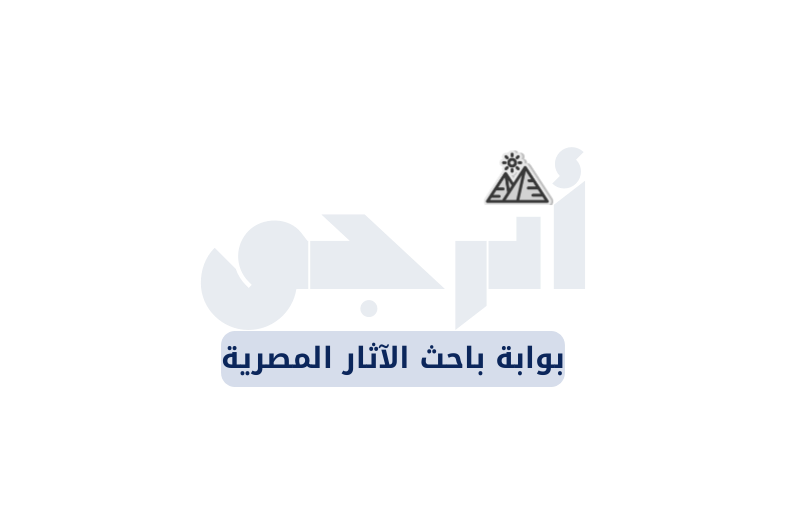نبذة عن الرسالة
اسم الباحث: أسامة سلام
عدد صفحات الرسالة: 29
نبذة عن محتوي الرسالة: یضم متحف مدرسة السلام مجموعة من الأوانی الکانوبیة ، تناولها الباحث بدراسة تحلیلیة لغویة أثریة من أجل إعادتها إلی موقعها الأصلی نظرا لأنهم مهداة إلی متحف المدرسة من تجاه العالم الأنجلیزی فلندرز بتری ، لذلک قام الباحث بالفحص وتبین أنهم مجموعتین مختلفین فی مادة الصناعة والشکل والنصوص المدونة علیهم فأضطر الباحث إلی تقسیمهم إلی مجموعتین (A, B) ، فالمجموعة A مکونة من أنائین مصنوعین من الطفلة Marl أحد مواد صناعة الفخار و غطائین أدمیین بدون أوانی الأحشاء ربما فقدا فی أثناء الحفائر وتم کسرهم أثناء عملیة النقل، وأرقامهم طبقا لسجل المتحف 212، 215، 216 (أ، ب) ویقابلهم من أرقام بتری 188، 189، 190، 191 – تبین للباحث وجود أحشاء بداخل الأنائین ودون علی أحدهما بالخط الهیراطیقی الکبیر نص الحمایة بالمداد الأسود یخص المعبود دوا موت أف وظهر علیه أیضا اسم المعبود أوزیر، تم دراسته لغویا وتبین أن صاحب هذه المجموعة من المرتلین للمعبودة ماعت، أما الأناء الثانی علیه بقایا النص الهیراطیقی بالمداد الأسود تمکن الباحث من التوصل إلی غالبیة النص و بغطاء علی هیئة المعبود قبح سنو أف وظهر علیه أیضا اسم المعبود أوزیر ودوا موت أف ، من فحص المجموعة A تبین أن جمیعهم بأغطیة أدمیة وهذا التقلید ربما بدأ من عصر الدولة الوسطی واستمر فی الأسرة الثامنة عشر، أما المجموعة B ضمت أربعة أوانی من الحجر الجیری فارغة من الأحشاء مسجلین بأرقام سجل المتحف 214، 210، 213،211 وما یقابلها من أرقام بتری 184، 185 ، 186، 187 وجمیعم کاملة ، وجد علی أحدهما نص بالمداد الأسود بالخط الهیروغلیفی والمعروف (بالکیرسیفی) واضح بعض الشیء والذی ظهر فی الدولة الحدیثة ، من دراسته لغویا تلاحظ أن هذه المجموعة تخص کاهن یدعی أوجا سماتاوی، وعلی أناء أخر وجد بقایا اللقب والاسم بالمخصص الذی أکد للباحث وظیفته واسمه، أما الأنائین الأخرین فلم یوجد علیهم أی کتابات بالمداد الأسود، وخلو هذه المجموعة من الأحشاء تثبت أن هناک أوانی وجدت فارغة من الأحشاء باعتبارها أوانی وهمیة قد ظهرت فی عصر الأنتقال الثالث والأسرتین الحادی والعشرین والثانی والعشرین. بعد الدراسة لمجموعة الأوانی تلاحظ للباحث أن التأریخ الحقیقی للمجموعتین الأسرة الثامنة عشر وذلک من علامات الخط الهیراطیقی، وتحدیدا الملک أمنحوتب الثانی، أما المجموعة الثانیة فمن الدراسة تبین أنها تعود أیضا إلی الأسرة الثامنة عشر، مما تثبت أن ظاهرة الأوانی الکانوبیة الوهمیة قد ظهرت قبل عصر الأنتقال الثالث وما بعدها، أیضا استفاد الباحث من أرقام التسجیل الخاصة بالعالم بتری وأرقام القطع التی سبق نشرها من تحدید موقع الکشف بجبل السلامونی مرکز أخمیم وأکد أن هذه المقابر استخدمت فی عصر الدولة الحدیثة وأعید استخدامها فی العصر المتأخر.
A Group of canopic jars, which was dedicated to the Museum of El-Salaam School in Assiut Governorate
by the English archaeologist Flinders Petrie, has been studied analytically, linguistically and archaeologically in this paper in order to date it properly and accurately. After examination, the researcher realized that the canopic jars constituted two different sets with respect to material, shape, and texts written on them. Accordingly, they were divided into two groups (A&B). Group A includes two jars made of marl clay; a substance used in pottery manufacturing, and two human- headed coffin lids without entrails, probably lost during excavation and were broken in transmission. Their museum recording numbers are 212, 215, 216 (a,b), while Petrie's excavation numbers 188, 189, 190, 191. The two jars contain entrails, and on one of them appeared a large hieratic protection text in black ink concerning god Duamutef, as well as the name of god Wsir. The researcher studied it linguistically and found that its owner was one of the chanters of goddess Maat. A remaining of the inky-black hieratic text was discovered on the second jar. The researcher managed to discover most of the text which was dedicated to god Qebehsenuf, and the name of gods Wsir and Duamutef appeared on it. It was detected that all jars of group A have a human- headed coffin lids; a tradition which presumably begun in the Middle Kingdom and continued to the 18th Dynasty. Group B includes four jars made of limestone, empty of entrails, and labeled in museum recording numbers as 214, 210, 211, 213, and Petrie's numbers 184, 185, 186, 187. One of them has a fairly visible inky-black hieroglyphic writing known as cursive, which appeared in the New Kingdom. After studying it linguistically, it was noticed that this group belonged to a priest called wDA smA-tAwy. Another jar which preserved the remains of the title and the name with determinative revealed to the researcher wDA profession and name, whereas the two other jars have no inky-black inscriptions. The fact that these jars have no entrails proved that there have been vessels empty of entrails which confirmed that the dummy or false canopic jars phenomenon appeared in the Third Intermediate Period as well as in 21th and 22th Dynasties. After studying these groups and according to the hieratic inscriptions written on the jars, the researcher concluded that the actual dating of the two groups was the 18th Dynasty, precisely Amenhotep II's reign. As for the second group, it dated back to the 18th Dynasty as well, which affirmed the idea that false canopic jars appeared before and after the Third Intermediate Period. The researcher has benefited from the recording numbers of both Professor Petrie and pieces previously published after locating the excavation site in El Salamuni Mountain, in Akhmim region, and confirmed that these tombs were used in the New Kingdom Period and were reused in the Later Period.









0 مراجعة